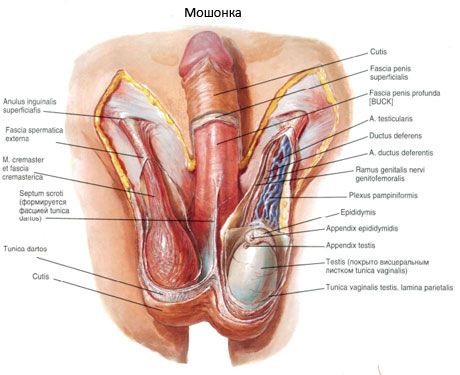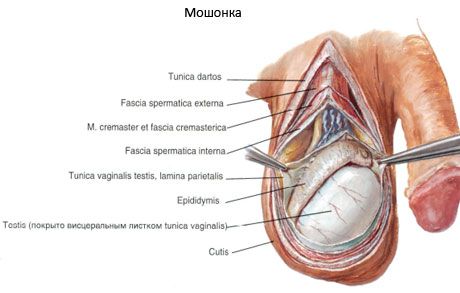Scrotum
Last reviewed: 23.04.2024

All iLive content is medically reviewed or fact checked to ensure as much factual accuracy as possible.
We have strict sourcing guidelines and only link to reputable media sites, academic research institutions and, whenever possible, medically peer reviewed studies. Note that the numbers in parentheses ([1], [2], etc.) are clickable links to these studies.
If you feel that any of our content is inaccurate, out-of-date, or otherwise questionable, please select it and press Ctrl + Enter.
Scrotum (scrotum) is a protrusion of the anterior abdominal wall, which has two disconnected chambers for the male genital glands. The scrotum is located down and behind the root of the penis. Inside the scrotum and in each of its cells is the male sex gland.
The scrotum distinguishes 7 layers (shells), which are also called the shells of the testicle:
- leather (cutis);
- fleshy shell (tunica dartos);
- external seminal fascia (fascia spermatica externa);
- fascia of the muscle that lifts the testicle (fascia cremasterica);
- muscle lifting an egg (m.cremaster);
- internal seminal fascia (fascia spermatica interna);
- the vaginal envelope of the testicle (tunica vaginalis testis), in which two sheets (two plates) are isolated: a parietal lamina (lamina parietalis) and an inner lamina (lamina visceralis).
The skin of the scrotum is thin, easily forms folds, has a darker coloration than in other parts of the body, is covered with numerous hairs. Under the skin is a fleshy shell (tunica dartos), formed from the subcutaneous connective tissue of the inguinal region and perineum and replacing the subcutaneous fatty tissue. In the fleshy shell there are bunches of smooth muscle cells and elastic fibers. There are no fat cells in it. The fleshy shell forms the scrotum septum (septum scroti), separating the right testicle from the left one. On the surface of the scrotum of the attachment line of the septum there corresponds a seam of the scrotum (raphe scroti), having a sagittal direction. Deeper lies the external seminal fascia, which is the derivative of the superficial fascia of the abdomen. Under it is the fascia of the muscle that lifts the testicle, formed from the fascia of the outer oblique abdominal muscle and partly from the fibrous fibers of its aponeurosis. Then the mice that lifts the testicle (m.cremaster), consisting of muscle beams, branching from the transverse and internal oblique muscles of the abdomen, are located. Inside the muscle is the inner seminal fascia - the derivative of the transverse fascia of the abdomen. The inner seminal fascia fuses with the parietal plate of the vaginal shell of the testicle, which at the posterior margin of the testicles passes into its internal (visceral) plate, which covers the testicle and epididymis. Between the visceral and parietal plates there is a slit-shaped closed cavity - a derivative of the peritoneal cavity.

Vessels and nerves of the scrotum
In the walls of the scrotum, the front scrotal branches (branches of the external genital artery) branch out, as well as the posterior scrotal branches (branches of the perineal artery). The branch of the lower epigastric artery approaches the muscle that lifts the testicle.
The anterior scrotal veins flow into the femoral vein, and the posterior scrotal veins are the inflows of the internal genital veins. Lymphatic vessels of the scrotum flow into the superficial inguinal lymph nodes.
Innervation of the scrotum is carried out through the front scrotal nerves - the branches of the femoral-genital nerve and the posterior scrotal nerves - from the genital nerve. Involuntary (smooth) muscles are innervated from the lower plexus plexuses.

Lowering the testicle and forming its shells
The shells of the male reproductive gland are formed during the lowering of the testicle, in which the guiding testicular bundle (gubernaculum testis - BNA) plays an important role. The ligament is laid in the early stages of development of the retroperitoneal and extends from the caudal end of the rudiment of the testicle to the anterior abdominal wall, where the scrotum subsequently begins to form. Somewhat later, at the 3rd month of intrauterine development, on the site of the future deep inguinal ring appears the protrusion of the peritoneum, which forms the epiduralisation processus (processus vaginalis peritonei). As the embryo's body grows in length, the testicle takes an increasingly lower position, blends retroperitoneally into the pelvic cavity, and then near the vaginal appendage of the peritoneum, where it is enveloped in a serous cover (the lower part of the vaginal process), occupying its final position. Together with the vaginal process, other layers of the anterior abdominal wall protrude outward, forming a receptacle of the male reproductive gland-the scrotum.


 [
[